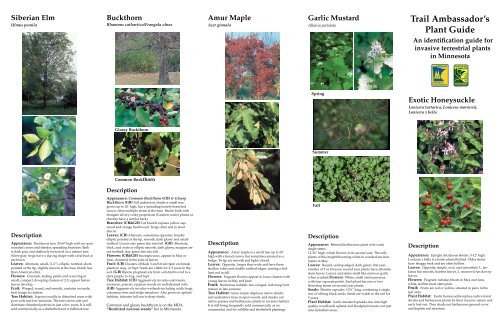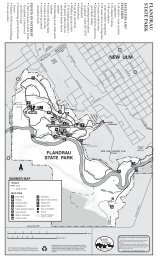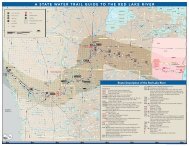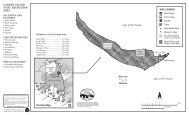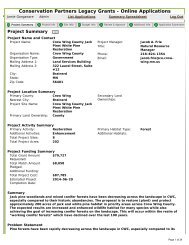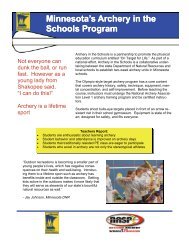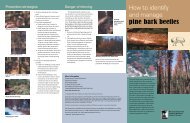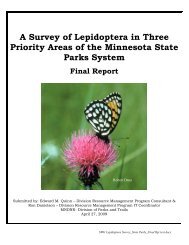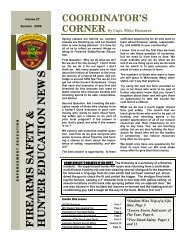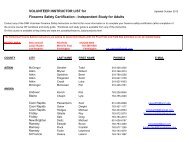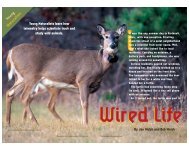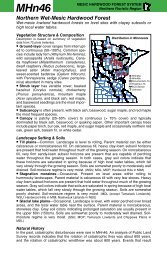Trail Ambassador Invasive Species - Minnesota Department of ...
Trail Ambassador Invasive Species - Minnesota Department of ...
Trail Ambassador Invasive Species - Minnesota Department of ...
Create successful ePaper yourself
Turn your PDF publications into a flip-book with our unique Google optimized e-Paper software.
Siberian Elm<br />
Ulmus pumila<br />
Buckthorn<br />
Rhamnus cathartica/Frangula alnus<br />
Amur Maple<br />
Acer ginnala<br />
Garlic Mustard<br />
Alliaria petiolata<br />
<strong>Trail</strong> <strong>Ambassador</strong>’s<br />
Plant Guide<br />
An identification guide for<br />
invasive terrestrial plants<br />
in <strong>Minnesota</strong><br />
VOLUNTEER TRAIL<br />
AMBASSADOR<br />
SAFE<br />
ETHICAL<br />
RESPONSIBLE<br />
Riders<br />
MINNESOTA DEPARTMENT<br />
OF NATURAL RESOURCES<br />
Spring<br />
Exotic Honeysuckle<br />
Lonicera tartarica, Lonicera morrowii,<br />
Lonicera x bella<br />
Glossy Buckthorn<br />
Summer<br />
Common Buckthorn<br />
Description<br />
Description<br />
Appearance: Deciduous tree, 30-60’ high with an open<br />
rounded crown and slender, spreading branches. Bark<br />
is dark gray and shallowly furrowed on a mature tree.<br />
Silver-gray twigs have a zig-zag shape with a leaf bud at<br />
each turn.<br />
Leaves: Alternate, small, (1-2”), elliptic, toothed, shortpointed<br />
at the tip, slightly uneven at the base (much less<br />
than American elm).<br />
Flowers: Greenish, lacking petals and occurring in<br />
small, compact, drooping clusters <strong>of</strong> 2-5, appear before<br />
leaves develop.<br />
Fruit: Winged, round, and smooth, contains on seeds;<br />
fruit hangs in clusters.<br />
Tree Habitat: It grows readily in disturbed areas with<br />
poor soils and low moisture. The tree can invade and<br />
dominate disturbed prairies in just a few years. It is still<br />
sold commercially as a shelterbelt and windbreak tree.<br />
Appearance: Common Buckthorn (CB) & Glossy<br />
Buckthorn (GB) Tall understory shrub or small tree,<br />
grows up to 20’ high, has a spreading loosely branched<br />
crown, <strong>of</strong>ten multiple stems at the base. Brown bark with<br />
elongate silvery corky projections (Caution: native plums or<br />
cherries have a similar bark).<br />
Branches: (CB&GB) Cut branch exposes yellow sapwood<br />
and orange heartwood. Twigs <strong>of</strong>ten end in stout<br />
thorns.<br />
Leaves: (CB) Alternate, sometimes opposite; broadly<br />
elliptic pointed at the tip, smooth, dark glossy and smalltoothed.<br />
Leaves stay green late into fall. (GB) Alternate,<br />
thick, and ovate or elliptic smooth, dark glossy, margins are<br />
not toothed; stay green late into fall.<br />
Flowers: (CB&GB) Inconspicuous, appear in May or<br />
June, clustered in the axils <strong>of</strong> leaves.<br />
Fruit: (CB) Clusters <strong>of</strong> black ¼ inch fruit ripen on female<br />
plants in Aug. or Sept. Seeds are viable for 2-3 years in the<br />
soil. (GB) Ripens progressively from a distinctive red to a<br />
dark purple in Aug. and Sept.<br />
Tree Habitat: (CB) Aggressively invades oak forests,<br />
savannas, prairies, riparian woods on well-drained soils.<br />
(GB) Aggressively invades wetlands including acidic bogs,<br />
calcareous fens and sedge meadows. Also grows in upland<br />
habitats, tolerates full sun to deep shade.<br />
Common and glossy buckthorn is on the MDA<br />
“Restricted noxious weeds” list in <strong>Minnesota</strong>.<br />
Description<br />
Appearance: Amur maple is a small tree up to 20’<br />
high with a broad crown, but sometimes pruned as a<br />
hedge. Twigs are smooth and light colored.<br />
Leaves: Opposite, longer than wide and have three<br />
shallow lobes and double toothed edges, turning a brilliant<br />
red in fall.<br />
Flowers: Fragrant flowers appear in loose clusters with<br />
young leaves in May and June.<br />
Fruit: Numerous reddish, two-winged, inch-long fruit<br />
mature in late summer.<br />
Tree Habitat: Amur maple displaces native shrubs<br />
and understory trees in open woods, and shades out<br />
native grasses and herbaceous plants in savanna habitat.<br />
It is still being frequently sold commercially as an<br />
ornamental, and for wildlife and shelterbelt plantings.<br />
Fall<br />
Description<br />
Appearance: Biennial herbaceous plant with weak<br />
single stems<br />
12-36” high, which flowers in its second year. The only<br />
plants <strong>of</strong> this height blooming white in wooded environments<br />
in May.<br />
Leaves: Round, scallop-edged, dark green; first year,<br />
rosettes <strong>of</strong> 3 or 4 leaves; second year plants have alternate<br />
stem leaves. Leaves and stems smell like onion or garlic<br />
when crushed.Flowers: White, small and numerous,<br />
with four separate petals. Each plant has one or two<br />
flowering stems on second year plants.<br />
Seeds: Slender capsules 1-2½” long, containing a single<br />
row <strong>of</strong> oblong black seeds. Seeds are viable in the soil for<br />
5 years.<br />
Plant Habitat: Garlic mustard spreads also into high<br />
quality woodlands upland and floodplain forests, not just<br />
into disturbed areas.<br />
Description<br />
Appearance: Upright deciduous shrubs, 5-12’ high.<br />
Lonicera x bella is a horticultural hybrid. Older stems<br />
have shaggy bark and are <strong>of</strong>ten hollow.<br />
Leaves: Opposite, simple, oval, and untoothed. L. tartarica<br />
has smooth, hairless leaves, L. morrowii has downy<br />
leaves.<br />
Flowers: Fragrant, tubular, bloom in May and June,<br />
white, red but most <strong>of</strong>ten pink.<br />
Fruit: Fruits are red or yellow, situated in pairs in the<br />
leaf axils.<br />
Plant Habitat: Exotic honeysuckle replace native forest<br />
shrubs and herbaceous plants by their invasive nature and<br />
early leaf-out. They shade out herbaceous ground cover<br />
and deplete soil moisture.
Common Tansy<br />
Tanacetum vulgare<br />
Wild Parsnip<br />
Pastinaca sativa<br />
Spotted Knapweed<br />
Centaurea maculosa<br />
Leafy Spurge<br />
Euphorbia esula<br />
Orange Hawkweed<br />
Hieracium aurantiacum<br />
Description<br />
Description<br />
Appearance: Perennial herbaceous plant, 3’ tall, up to 5’<br />
in shaded areas, and erect. A single stem branches extensively<br />
toward the top into short stems forming a flat-topped<br />
cluster <strong>of</strong> numerous button-like flower heads; plants have<br />
medicinal properties.<br />
Leaves: Alternate, pinnately compound (leaflets arranged<br />
on both sides <strong>of</strong> a common stalk), irregularly lobed.<br />
Leaves become smaller towards the top <strong>of</strong> the stalk, and are<br />
strongly aromatic when crushed.<br />
Flowers: Bright yellow daisy-like discs up to ½” wide,<br />
lacking rays, blooming from July through October.<br />
Seeds: Numerous tufted seed dispersed by wind and<br />
water.<br />
Plant Habitat: It is common along roadsides and<br />
abandoned farmyards in northern <strong>Minnesota</strong> and along the<br />
north shore <strong>of</strong> Lake Superior. South facing open areas are<br />
most vulnerable.<br />
Common tansy is on the MDA “Secondary noxious<br />
weeds” list in <strong>Minnesota</strong>.<br />
Appearance: Monocarpic perennial herbaceous plant<br />
(plant spends one or more years in rosette stage, blooms<br />
under favorable conditions, and then dies), 6” high in the<br />
rosette stage and 4’ high on stout, grooved stems in the<br />
flowering stage.<br />
Leaves: Alternate, leaf is made up <strong>of</strong> 5-15 egg-shaped<br />
leaflets along both sides <strong>of</strong> a common stalk; leaflets sharplytoothed<br />
or lobed at the margins; upper leaves smaller.<br />
Flowers: Flat-topped broad flower cluster 2-6” wide,<br />
numerous five-petaled yellow flowers; blooms from June to<br />
late summer.<br />
Seeds: Small, flat, round, slightly ribbed, straw-colored,<br />
abundant take 3 weeks to ripen before they can reseed; viable<br />
in the soil for 4 years.<br />
Plant Habitat: It readily moves into disturbed habitats,<br />
along edges and/or in disturbed patches. It invades slowly,<br />
but once population builds it spreads rapidly and can<br />
severly modify open dry, moist, and wet-moist habitats.<br />
Caution – Avoid skin contact with<br />
the sap <strong>of</strong> the plant tissue by wearing<br />
gloves, long sleeves and long pants.<br />
The juice <strong>of</strong> wild parsnip in contact<br />
with skin in the presence <strong>of</strong> sunlight<br />
can cause a rash and blistering and<br />
discoloration <strong>of</strong> the skin.<br />
Description<br />
Appearance: Biennial or short-lived perennial herbaceous<br />
plant, 2-3’ high. Basal leaves form a rosette the first year<br />
from which grow 1-20 wiry, hoary, branched stems during<br />
the second year. Leaves: Alternate, grayish, hoary, and<br />
divided into lance-shaped lobes decreasing in size at the top.<br />
Flowers: Thistle-like pink to purple flowers sit at the tips<br />
<strong>of</strong> terminal and axillary stems, bloom from July through<br />
September.<br />
Seeds: Brownish, ¼” long with small tufts <strong>of</strong> bristles,<br />
dispersed by rodents, livestock and commercial hay. Seed<br />
viable in the soil for 7 years.<br />
Plant Habitat: Spotted knapweed spreads rapidly in<br />
artificial corridors, gravel pits, agricultural fields margins<br />
and overgrazed pastures.<br />
Caution ‐ Wear long sleeves and gloves, can be a<br />
skin irritant to some people.<br />
Spotted knapweed is on the MDA “Secondary<br />
noxious weeds” list in <strong>Minnesota</strong>.<br />
Description<br />
Appearance: Perennial herbaceous plant, 2-3½ tall, erect<br />
branching, smooth stems growing from a deep vertical root.<br />
Stems, flowers, and leaves emit a white milky sap when<br />
broken.<br />
Leaves: Alternate, small, oblong to lance-shaped, on the<br />
upper part <strong>of</strong> stem; scale-like on the lower part <strong>of</strong> the stem.<br />
Flowers: Small, borne by showy yellow-green bracts<br />
which open in late May; flowers bloom from June into fall.<br />
Umbrella-shaped flower cluster, 7-10, at the top <strong>of</strong> each stem,<br />
single, stemmed flowers from leaf axils below.<br />
Seeds: Explosive dispersal from a seed capsule up to 15’;<br />
high germination rate; seeds remain viable in the soil for 7<br />
years.<br />
Plant Habitat: Tolerant <strong>of</strong> a wide range <strong>of</strong> habitats, from<br />
dry to moist, and sunny to semi-shade. Invades primarily<br />
non-cropland disturbed environments such as roadsides.<br />
Leafy spurge is on the MDA “Prohibited noxious<br />
weeds” list in <strong>Minnesota</strong>.<br />
Description<br />
Appearance: Perennial herbaceous plant, 10-20” high;<br />
each hairy stem bears one or a dense cluster <strong>of</strong> dandelionlike,<br />
orange or yellow flowerheads. The stem grows from a<br />
basal rosette <strong>of</strong> hairy leaves. Hawkweeds colonize and can<br />
rapidly dominate a site. They grow well on disturbed, dry<br />
low-productivity soils.<br />
Leaves: Hairy rosette made up <strong>of</strong> entire or minutely<br />
toothed leaves, spatula-shaped, 4-6” long. They are dark<br />
green above and lighter green beneath.<br />
Flowers: Bright yellow or orange dandelion-like, ½” to<br />
¾” in diameter; arranged in a dense flat-topped cluster <strong>of</strong><br />
flowers.<br />
Seeds: Each flower bears 12-30 tiny, columnar seeds with a<br />
light-brown tuft <strong>of</strong> bristles for wind dispersal. Seeds are viable<br />
in the soil for up to 7 years.<br />
Plant Habitat: Orange hawkweed invades northern moist<br />
pastures, forest openings, abandoned fields, clearcuts and<br />
roadsides.Note: There are two native hawkweeds in <strong>Minnesota</strong>,<br />
which differ from non-native hawkweeds.<br />
Orange hawkweed is listed on the MDA “Secondary<br />
noxious weeds” list in <strong>Minnesota</strong>.


